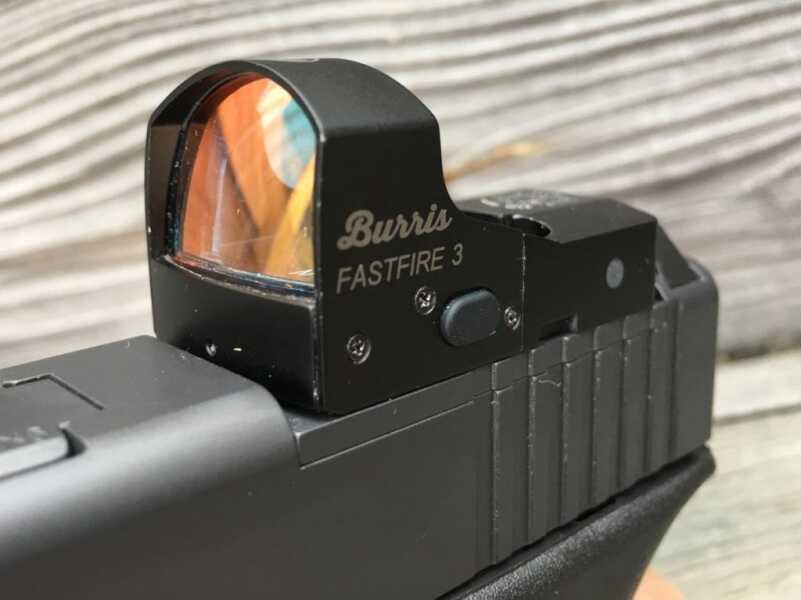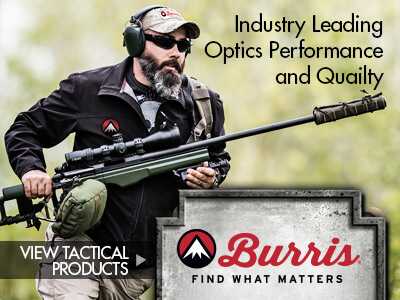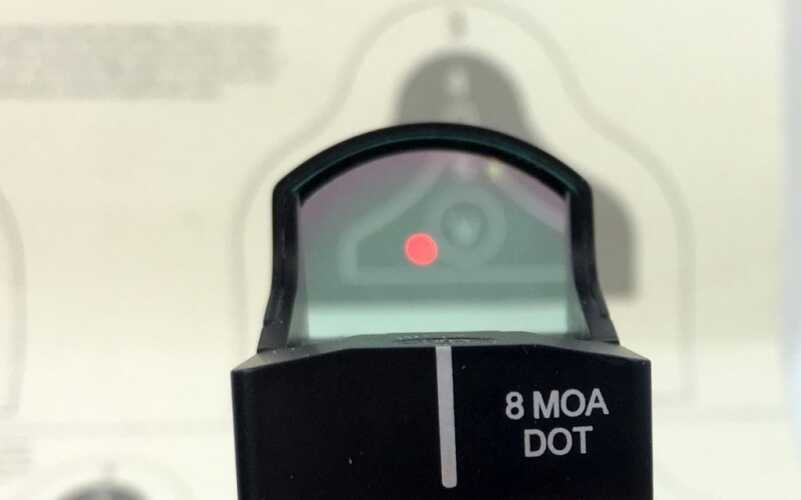

Enhanced speed and field of view benefits make red dot sights a great option for handguns or rifles.
THE SERIES

- Part 1: Optics Buying Guide: Iron Sights, Red Dots, and Scopes
- Part 2: Optics Buying Guide: Top Must-Know Terms for Picking the Right Scope
- Part 3: Optics Buying Guide: Scope Mounts
- Part 4: Optics Buying Guide: How To Properly Zero Your Scope
- Part 5: Optics Buying Guide: Finding Your Range with a Scope Reticle
- Part 6: Optics Buying Guide: Hold Off vs. Adjustable Scope Turrets
- Part 7: Optics Buying Guide: Scope Reticles
- Part 8: Optics Buying Guide: Using a Laser Rangefinding Scope
- Part 9: Optics Buying Guide: Holographic and Red Dot Optics
- Part 10: Optics Buying Guide: AR-15 Optics and Scopes
- Part 11: Optics Buying Guide: Big Scopes
- Part 12: Optics Buying Guide: Do You Get What You Pay For?
Red dot sights are like Coke. Where I live, any non-alcoholic beverage that fizzes is called “a Coke.” That’s kind of like how people refer to reflex and holographic sights. Most of us call them “red dots” no matter what the underlying technical differences are. In this episode of the optics buying guide, we’re going to get a little bit geeky, but still practical, about the different types of “red dots” and how one might use them.
What are red dot and holographic sights?
We tend to lump all sights like this into one general category and call them something like “red dots,” but we’re really talking about two different technologies here. The first is a reflex, which is short for non-magnifying reflector and the second is a holographic sight. Let’s take a quick look at how they’re different.
A reflex sight uses a simple LED (light emitting diode) to create a red dot. This dot is beamed onto the lens of the optic. Under normal conditions with a pure piece of glass, you wouldn’t be able to see the dot. The reason you do is that the glass lens of a reflex red dot sight is coated with a nifty magical material that reflects the red light back to you rather than letting it pass through. Other colors pass right through the lens, so you see the environment in front of you with a red dot superimposed on your view. It’s a nifty trick that takes advantage of the high-tech coating being able to bounce some wavelengths back while allowing others to pass through.
A holographic sight uses no such coating on the lens. Instead of an LED light source, a holographic site uses a laser to provide the illuminated reticle. The laser is reflected off a holographic grid that’s out of the direct field of view. That grid contains the reticle pattern and laser light bounces off that and onto the lens that you see. The result is an illuminated image of the reticle pattern that appears to hover on the optic lens.
I point out the differences between the two styles for a couple of reasons. First, the reflex sight allows for a simple dot since the reflective technology just bounces the light from a simple LED onto the lens. A holographic sight allows manufacturers to design a complete reticle pattern, like a circle and dot. Since holographic sights use a laser, which draws much more power, battery life can be a fraction of that of reflex type sights. That’s why reflex sights like the Burris Fastfire series have batteries that seem to last 75% of forever.
What are the benefits of reflex and holographic sights?
One of the big reasons people like holographs and red dot sights is that they are so forgiving compared to a magnified scope. When I say “forgiving,” I’m referring to a couple of different things.
Eye relief is a big one. With most red dot sights, whether reflector or holographic, it doesn’t make a whole lot of difference whether your eye is one inch or ten from the lens. You can generally see the sight picture clearly.
On a related note, the zero magnification nature of sights like this makes it much easier to see everything clearly when looking through the site with both eyes open. Conceptually, it’s no different than sticking a cardboard paper towel tube over one eye while keeping the other open. It’ll look a little weird, but you’ll be able to see through both eyes clearly. Now imagine putting a 200 power telescope over one eye while keeping the other open. That’s an exaggeration, but I think you get the point.
Another big advantage to zero magnification sights is that you have a maximum field of view down range. Barring interference from the side walls of the red dot sight, you can see a very wide area down range, making the sights fast for target acquisition and easy to use on moving targets. Of course, the lack of magnification comes at a cost. Your ability to see distant targets is limited by your eyesight.
Another advantage is the lack of parallax or visual distortion that can occur in scopes with higher magnification levels. That’s a complex topic, so let’s diverge for a minute.
Parallax
The easiest way to understand parallax is to get in your car. From the driver’s seat, look at the speedometer when you’re cruising along at 70 miles per hour. The needle will appear to be exactly on the 70. Now, look from the passenger seat position, ideally when someone else is driving. To the driver, the needle will still appear to be on the 70, but from your position in the passenger seat, the needle will appear to be somewhere in the 65 range, give or take. That’s because the numbers on the dial are in a different focal plane than the needle itself. In most cars, the needle will be ¼ or ½ inch above the surface of the dial. When you look at it from the side, the needle will appear to be in a different position than it really is. The closer the needle is to the dial surface, the less “error” you’ll see, because both are almost in the same focal plane.
The same thing happens with optics of any kind. On a magnified scope, the manufacturer has to “focus” the reticle at some distance. Often this is 100 yards. For higher power scopes where you’ll shoot at longer ranges, this 100-yard focal point compared to the focal plane where you target resides is just like the needle and dial scenario, only a lot more dramatic. The result is that if your eye is not directly in front of the reticle center and target line, things will appear out of whack. This phenomenon happens with red dots too, but the impact is usually far less than with a magnified scope. While many believe that red dots are parallax free, the reality is that the optic has minimal parallax effect meaning there’s not enough parallax to worry about in a practical sense.
For red dot sights, given the ranges involved and acceptable aiming precision, parallax isn’t a very big deal. You can experiment with your own optic by putting it in a stationary position on a table aimed at something and moving your eye from side to side. If you see the dot moving relative to the target, that’s parallax. As an impromptu experiment for this article, I mounted a Burris FastFire 3 on a new Glock 19 MOS pistol. Putting the (empty) gun in a stationary position, I aimed it at a four-inch wide fence post 10 yards away – a rational pistol shooting distance. I then positioned the pistol at arm’s length as if I were shooting and moved my head side to side relative to the stationary optic until I could no longer see the dot at all through the optic lens. If the dot moved ¼ inch in either direction, I’d eat my hat. I couldn’t detect any movement on the target. Was parallax present? Sure. Did it matter? Not at all.
Practical considerations
Compared to iron sights, red dots are incredibly easy to shoot with. Since the red dot hovers at “infinity distance” by design, it appears to rest right on your target. Rather than your brain trying to deal with things at three different distances (rear sight, front sight and target), you can focus solely on the target, and the dot will appear in the same focal plane. There’s no complicated alignment to worry about. As long as you manage the trigger properly, you’ll hit wherever the dot resides. It’s not only a great way to teach new shooters, it is a real aid to those of us with aging eyes.

There’s no reason you can’t mount a red dot like this FastFire 3 on a magnified optic. Shown here mounted on a fixed 3x Burris AR-332 optic.
Red dot sights are far more useful than one might assume. Most people have a tendency to over-magnify optics on their rifles. Unless your goal is to hit quarter-sized targets at a couple of hundred yards, there’s no need for big magnification. Consider that a Burris FastFire 3 red dot sight has a 3 MOA (minute of angle) dot. That means that at 100 yards, that dot covers only three inches of the target. At 200 yards, still a highly visible range to the human eye, the dot only covers six inches. In a hunting or defensive application, that’s plenty of precision for those ranges, especially when you consider the speed and field of view benefits. There’s not much faster than a quality red dot when it comes to target acquisition and getting off a first shot.

With a dual-mount scenario, just move your eye up an inch and you have a whole new sight picture through the red dot.
On pistols, a red dot optic most likely has more precision than the handgun is capable of anyway. If a pistol shoots two-inch groups at 25 yards, that means it will shoot an eight-inch group at 100 yards. That’s about eight MOA of accuracy. The three MOA dot is actually far more precise than most pistols are capable of shooting. Even the eight MOA version of the Fastfire 3 more or less matches the practical accuracy of most pistols. If you cover your desired impact zone, the shot will land inside. Perhaps that’s one of the reasons that red dots have dominated the open divisions of various handgun competitions for years.
When to consider a red dot sight
In Europe, red dot sights are very popular on hunting rifles, probably because of the wide field of view and speed at which one can hit a moving target. Across the pond, there’s a lot more shooting at moving game than we typically do over on the left side of the puddle. Clearly, if your shooting wants and needs include speed to target, a red dot sight might be right for you.
In addition to raw speed, you also might consider the more intangible factor of “speed with precision.” With a red dot, you’re never going to be able to print ½-inch groups at 100 yards. But you can hit a target area measured in the several inch range very fast. Without the fine tweaking required to get the right eye relief and find the target as with a magnified scope, you might have a hit while the person with a high-power scope is still looking.
If the majority of your shooting scenarios happen at less than 200 yards, you might lean towards a red dot. With practice, there’s no reason you can’t nail an eight-inch target anywhere from zero to 200 yards using a zero magnification red dot.
Handgun use is another area where a red dot might shine. In my testing, I find that I can get better accuracy with more speed at ranges beyond five yards. At ranges closer than that, I generally find myself point shooting anyway, so the red dot benefit is reduced.
You also might consider using a red dot in conjunction with a magnified optic. As an example, the FastFire 3 has optional mounts that allow you to mount it on top of, or angled to the side of, a traditional scope. A slight turn of the head will allow you to use the red dot for shorter range shooting while the magnified scope is always available for longer shots.
Before you default to big magnification, try out a red dot. You might be surprised at what you can do with an unmagnified optic.



Thanks for your valuable giveaway! I’m a kayak fisherman and I used to fish for whole night. I just need a flashlight for my fishing purpose. As I’ve searched online for something waterproof, I found this. Now I’ve made my decision what I want to spend dollers for!
One consideration is those with Astigmatism. Depending if you are myopic, or hyper-optic , the dot can appear blurry. Holographic dots tend to be worse for some. Look though both types, with your shooting eye, before purchasing. Some posters might have more “insight” than I, please feel free to add some info.
While I am a fan of Red Dot Sights, we often have more experienced shooters telling us that they are not. Simply because they believe it makes you lazy. Some feel they shoot better without and some with. This is a comprehensive guide and definitely one worth reading. It is important though to note that at the end of the day it all comes down to personal preference.
Red dot sight vs Holographic Sight-Top Red Dot Sights:
Ah yes. The age-old dilemma: red dot sight vs holographic sight. There are people who think that one is better than the other. And then there are people who don’t even recognize the difference between the 2 sights well enough to debate about it.
Visit for More Information:
https://topreddotsights.com/red-dot-sight-vs-holographic-sight
I find it hard to maintain accuracy while using red dots. My “zero” point seems to move around like I’m never looking through the optic the same way. When I use the iron, I feel like I see the same sight picture, front blade in a peep sight on target. With a red dot I don’t feel as if I’m looking exactly down the rifle (Socom16), like it’s off just a touch. What keeps them lined up horizontally and vertically like my iron sights or, what should I be doing to get the same picture down the red dot.
Thanks.
If don’t have a lot of money lying around like myself, Then you can do research which is time consuming as hell , but I usually find what I’m looking for like the BSA red dot for the money you cant beat it, so if you don’t have $150- $200 for a red dot try a BSA red dot, I think you will like it !!!!
I noticed with a couple of cheaper sights I bought you get a red blotch instead of a red dot. Is there any adjustment for that?
I had the same experience and didn’t understand the cause….. until I removed my glasses. Fixed the blurry dot immediately. Worth a try.
Ralph, I would suggest checking out the Vortex Sparc2 ($199-ish) and Vortex StrikeFire ($179-ish) are the best value out there, in my opinion. High quality & great warranties, I’ve been happy enough with these over the years that I have never stepped up into the higher-priced Eotechs and/or Trijicons. The Spark2 is a little smaller, while the StrikeFire2 has a few more options. Personally, for my own peace of mind, I wouldn’t drop below this for any firearm that may have a personal defense use.
Great article. Just wish there was a convenient option to print.
@commonwealth109 ~ Get “Pocket,” a free bit of software that allows you to download and save any webpage in both text-only and “original” which shows the entire webpage, adverts, and everything. Once it is on your computer, phone, pad, or whatever, you can print it, save it as a PDF, or just leave it in the Pocket folder. There are also several browser add-ons for clicking on a button that actually downloads the webpage to your main Pocket folder. It’s brilliant, and did I mention FREE?
Oops! My comment above was actually meant for @AndyP.
I am looking for a red dot for my 300 blackout for personal protection. I need something for 100 yards or less. A friend gave me a cheap red dot and it wont hold zero. I need something to hold zero up to 100 yards. I mostly shoot supersonic, but sometimes shoot subsonic. I have looked at Eotech XPS2-300. I don’t really care for the circle in the sight. Any suggestions?
Thanks.
I recently picked up the Trijicon MRO and although I’ve only used it at the range once, I love it. Held zero beautifully after a few hundred rounds. It’s just a single dot as well, nothing else. Not as much FOV as the EO’s but still very thin bezels so it’s far better than most. …cheaper than EO’s too. I found mine from an authorized distributor on Ebay for under $400.